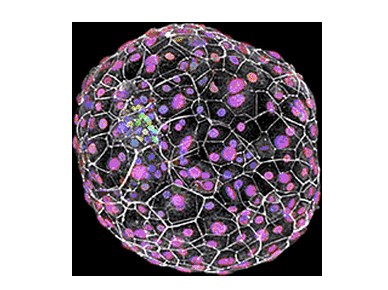|
by Audrey Lee '16 and ScM '17 At one point in our lives we were all just a 3-D ball of cells. How did we develop from a single cell to the diverse beings that we are today? Understanding the complexity of mammalian development requires maintenance of live embryos in a laboratory setting. And with research surrounding living embryos comes regulations. The rules outlining embryo research may be re-visited with recent advancements that allow scientists to maintain live embryos for at least two weeks.  Cell types of an early human embryo six days after fertilization that indicate cell boundaries (white), the inner cell mass (green) that will give rise to the fetus, and cells that supply the embryo with nutrients (purple and magenta). Source: The Rockefeller University Credit: Gist Croft, Alessia Deglincerti, and Ali H. Brivanlou The initial stages of embryonic development are critical, yet difficult to observe when an embryo is in the womb. In order to gain insights into the dynamic process of development, scientists have discovered methods to sustain live embryo development in culture dishes outside of the womb. By observing developing embryos in real time, researchers can better understand the processes of normal development and address causes of abnormal development that occur during the early stages of life. The 14-day rule limits research on developing embryos to embryos that are less than 14 days old [1]. Researchers are able to experiment on these embryos until the primitive streak forms, which happens around day 15 of human development. The primitive streak is a faint band of cells that marks the beginning of the embryo’s head-to-tail axis [2]. Usually, researchers are not even able to see the primitive streak of mammalian embryos due to the inability of these embryos to survive for two weeks outside of the womb and in a laboratory.
This policy has been in place for over 35 years and reaches international scale. While first proposed by the Ethics Advisory Board of the U.S. Department of Health, Education, and Welfare in 1979, the 14-day rule has been adopted by at least a dozen other nations since then [3]. It was not difficult for researchers to follow the rule, largely because it was impossible to keep embryos alive in the laboratory for two weeks. In practice, scientists have been unable to grow embryos in vitro for more than nine days [2]. But, it looks like that might be changing. Recently, two separate research groups, one in America and the other in Britain, have developed a method that allows in vitro embryonic development to continue for up to 13 days. Using a mix of proteins, hormones, and growth factors, researchers can sustain properly developing human embryos in a culture dish. The cells of these embryos were found to organize themselves into the early stages of development, sparking intrigue among developmental biologists [4, 5]. While it is unclear whether or not the cocktail of nutrients will be able to carry in vitro embryonic development past 14 days, these modern advances have triggered discussion surrounding the 14-day rule. These conversations consider the roles of ethics and morality in scientific discovery [6]. Due to the recency of these events, it is unclear whether or not the 14-day rule will be changed. But any changes would require considerable international debate across multiple disciplines given the novelty and implications of sustaining embryonic development past two weeks. Sources:
0 Comments
Leave a Reply. |
